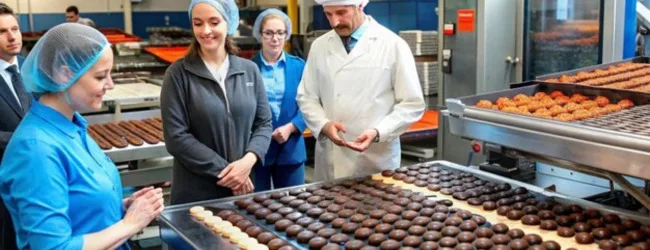Table of contents
Dreaming of a business that’s both delicious and profitable? A chocolate manufacturing business in India holds immense potential, given the nation’s growing love for sweet treats. This article will guide you through the essential steps, ensuring you build a successful and thriving enterprise.
Why Jump into the Chocolate Manufacturing Business Now?

The timing for entering the Indian chocolate market is particularly opportune due to several converging factors:
- Growing Disposable Incomes: India’s middle class is expanding, leading to increased discretionary spending on premium food products, including chocolates.
- Changing Consumer Preferences: There’s a noticeable shift towards higher-quality, artisanal, and healthier chocolate options. Consumers are increasingly seeking unique flavors, organic ingredients, and ethical sourcing.
- Festive Culture: India’s rich tapestry of festivals and celebrations provides a consistent demand for chocolates as gifts and treats. From Diwali to Christmas and numerous regional festivals, there’s always a reason to indulge.
- E-commerce Growth: The proliferation of online platforms has made it easier than ever to reach a wider audience and establish a direct-to-consumer (D2C) sales channel. This removes traditional barriers to entry and allows smaller businesses to compete effectively.
- Rise of the “Experience Economy”: Consumers are increasingly valuing experiences over material possessions. Artisanal chocolate businesses that offer tasting experiences, workshops, and personalized services can capitalize on this trend.
- Increased awareness of cocoa’s health benefits: Dark chocolate with a high percentage of cocoa is being promoted as a healthy option, creating more demand.
- Increased demand for gift-giving: In corporate and personal events, chocolate is now a very popular gift-giving option.
Niches in the Chocolate Manufacturing Business

- Artisan/Gourmet Chocolates: This niche focuses on producing high-quality, handcrafted chocolates with unique flavors and ingredients.
- Examples: Single-origin chocolates, truffles with exotic fillings, chocolates infused with spices, and visually stunning chocolate sculptures.
- Target audience: Affluent consumers, food enthusiasts, and those seeking premium gifts.
- Key differentiators: High-quality ingredients, unique flavor combinations, and exquisite presentation.
- Organic/Vegan Chocolates: This niche caters to the growing health-conscious and environmentally aware consumer base.
- Examples: Vegan chocolates made with plant-based milk alternatives, organic chocolates sourced from sustainable farms, and sugar-free chocolates.
- Target audience: Vegans, vegetarians, and consumers with dietary restrictions.
- Key differentiators: Use of organic and vegan ingredients, ethical sourcing, and transparent labeling.
- Customized/Personalized Chocolates: This niche offers personalized chocolates for events, corporate gifting, and special occasions.
- Examples: Chocolates with personalized messages, logos, or photos, chocolate gift boxes for weddings and birthdays, and corporate chocolate hampers.
- Target audience: Corporate clients, event planners, and individuals seeking unique gifts.
- Key differentiators: The ability to personalize products, fast turnaround times, and a high-quality finished product.
- Regional Flavored Chocolates: This niche capitalizes on India’s diverse culinary heritage by incorporating traditional Indian sweets and spices into chocolates.
- Examples: Chocolates infused with cardamom, saffron, or rose, chocolates inspired by regional sweets like Mysore Pak or Rasgulla, and chocolate-covered Indian snacks.
- Target audience: Consumers seeking unique and culturally relevant chocolates.
- Key differentiators: Authentic regional flavors, high-quality ingredients, and innovative product development.
- Functional Chocolates: This is a growing niche that integrates health-enhancing ingredients into chocolate.
- Examples: Protein-enriched chocolate, vitamin-enhanced chocolate, chocolate with added superfoods, or even chocolate that aids sleep.
- Target audience: Health-conscious consumers, athletes, and those seeking functional food products.
- Key differentiators: Health benefit claims, use of high-quality functional ingredients, and scientific backing.
- Chocolate-based beverages and spreads: This niche expands beyond solid chocolate products.
- Examples: High-quality hot chocolate mixes, chocolate-based protein shakes, and gourmet chocolate spreads.
- Target audience: A wide variety of customers, from children to athletes and general consumers.
- Key differentiators: High-quality ingredients, unique flavors, and healthy options.
Phase 1: Foundation and Planning for Chocolate Manufacturing Business

- Ideation and Concept Development:
- Define your passion: Are you drawn to artisanal creations, health-focused chocolates, or unique regional flavors?
- Brainstorm product ideas: Explore different chocolate varieties, fillings, and packaging concepts.
- Develop your unique selling proposition (USP): What will make your chocolates stand out?
- Market Research and Niche Selection:
- Analyze the Indian chocolate market: Identify growth trends, consumer preferences, and the competitive landscape.
- Select your target audience: Define their demographics, psychographics, and purchasing habits.
- Choose a niche: Focus on a specific segment like artisan, organic, customized, or regional chocolates.
- Conduct competitor analysis: Evaluate their strengths, weaknesses, and market positioning.
- Business Plan Creation:
- Executive summary: A concise overview of your business concept.
- Company description: Your mission, vision, and values.
- Market analysis: Detailed research on your target market and competitors.
- Product and service offerings: Description of your chocolate products and services.
- Marketing and sales strategy: How you will reach and attract customers.
- Operational plan: Details on production, sourcing, and logistics.
- Financial projections: Startup costs, revenue forecasts, and profitability analysis.
- Legal and Regulatory Compliance:
- Choose a business structure: Sole proprietorship, partnership, or private limited company.
- Register your business: Obtain the necessary registrations and licenses.
- Secure an FSSAI license: Essential for food manufacturing businesses.
- Register for GST: Comply with tax regulations.
- Obtain a trade license: From your local municipality.
- Address environmental regulations: Obtain necessary clearances if applicable.
- Financial Planning and Funding:
- Estimate startup costs: Equipment, raw materials, packaging, marketing, and operational expenses.
- Determine funding sources: Personal savings, bank loans, or government schemes.
- Develop financial projections: Revenue, expenses, and profitability.
- Create a budget: Track your spending and manage your finances.
ALSO READ | Sweep into Success: Blueprint for Broom Manufacturing Business
Phase 2: Setup and Production

- Location Selection and Facility Setup:
- Choose a suitable location: Consider accessibility, space, and hygiene standards.
- Design your manufacturing layout: Optimize workflow and ensure food safety.
- Procure essential equipment: Melting machines, tempering machines, molding machines, cooling tunnels, and packaging equipment.
- Raw Material Sourcing:
- Identify reliable suppliers: Source high-quality cocoa beans, sugar, milk powder, and other ingredients.
- Establish supplier relationships: Negotiate favorable terms and ensure a consistent supply.
- Implement quality control measures: Verify the quality and safety of raw materials.
- Recipe Development and Standardization:
- Create unique and appealing chocolate recipes.
- Standardize recipes for consistent quality and taste.
- Conduct taste tests and gather feedback.
- Production and Quality Control:
- Implement strict hygiene and sanitation protocols.
- Establish quality control measures: Monitor production processes and ensure product quality.
- Implement packaging standards: Maintain freshness and appeal.
💡 Pro Tip: If you want to start a business but have too many doubts, connect with a food business expert from Boss Wallah for guidance – https://bw1.in/1116
Phase 3: Marketing and Growth

- Branding and Marketing
- Create a compelling brand identity: Logo, colors, and messaging.
- Develop a website and social media presence.
- Implement digital marketing strategies: SEO, social media marketing, and email marketing.
- Explore offline marketing: Partnerships with retailers, participation in events, and local advertising.
- Distribution and Sales:
- Establish distribution channels: Retail stores, supermarkets, online marketplaces, or direct-to-consumer sales.
- Develop a sales strategy: Pricing, promotions, and customer service.
- Explore e-commerce opportunities: Set up an online store or partner with e-commerce platforms.
- Growth and Expansion:
- Introduce new product lines: Diversify your offerings to attract new customers.
- Expand your distribution network: Reach new markets and customers.
- Explore export opportunities: Expand your business internationally.
- Focus on customer retention: Build strong relationships and encourage repeat business.
- Continuously innovate: Stay up to date on trends, and create new and exciting products.
Need Expert Guidance?
Starting a business can be challenging, but you don’t have to do it alone! At Boss Wallah, our 2,000+ business experts are ready to provide valuable insights and guidance. Whether you need help with marketing, finance, sourcing, or any other area of any business, our business experts are here to help you succeed- https://bw1.in/1116
Confused about Which Business to Start?
Want to start your own business but unsure which one to choose? Explore Boss Wallah, where you’ll find 500+ courses by successful business owners, featuring practical, step-by-step guides on starting and growing various businesses.
Find your perfect business idea today – https://bw1.in/1111
Conclusion
Starting a chocolate manufacturing business in India requires careful planning, dedication, and a passion for creating delicious chocolates. By following the steps outlined in this article, you can build a successful and rewarding business that brings joy to chocolate lovers across the country. Remember that quality, innovation, and effective marketing are key to long-term success.
Frequently Asked Questions (FAQs)
- What is the initial investment required to start a chocolate manufacturing business?
- The initial investment can vary significantly depending on the scale of your operation, equipment, and location. It can range from a few lakhs to several crores.
- What are the essential licenses and permits required?
- FSSAI license, GST registration, trade license, and pollution control board clearance (if applicable).
- How do I find reliable suppliers for raw materials?
- Attend industry trade shows, search online directories, and network with other food manufacturers.
- What are the best marketing strategies for a chocolate manufacturing business?
- Online marketing, social media, collaborations with retailers, and participation in food events.
- How can I ensure the quality of my chocolates?
- Use high-quality raw materials, follow standardized recipes, implement strict hygiene protocols, and conduct regular quality checks.
- What are the popular chocolate varieties in India?
- Milk chocolate, dark chocolate, white chocolate, fruit and nut chocolates, and flavored chocolates.
- Is there a demand for organic and vegan chocolates in India?
- Yes, there is a growing demand for organic and vegan chocolates among health-conscious consumers.
- What are the potential challenges of starting a chocolate manufacturing business?
- Competition, fluctuating raw material prices, and maintaining consistent quality.


